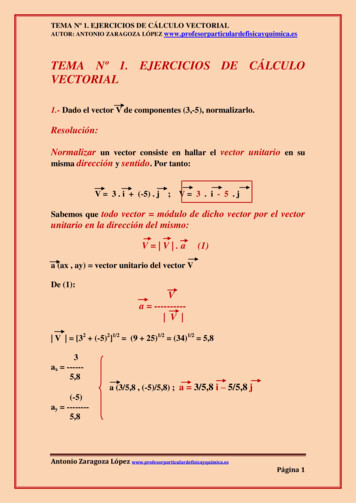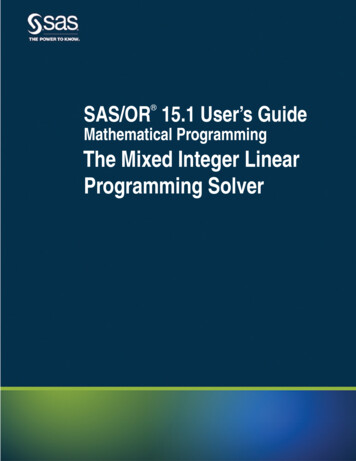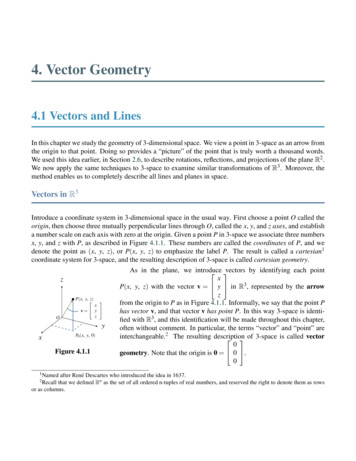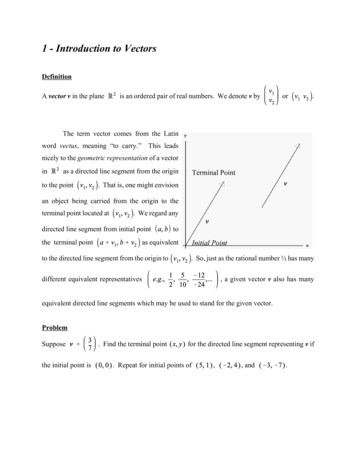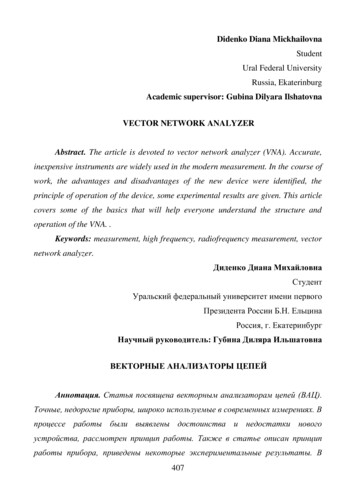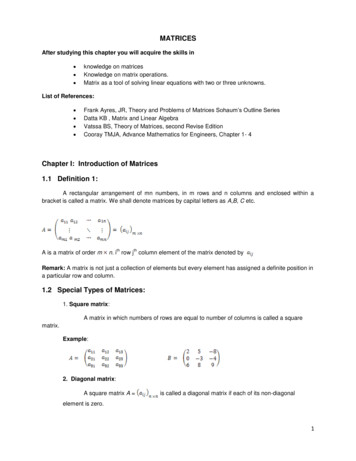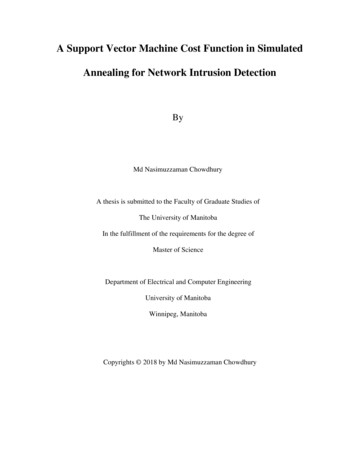
Transcription
A Support Vector Machine Cost Function in SimulatedAnnealing for Network Intrusion DetectionByMd Nasimuzzaman ChowdhuryA thesis is submitted to the Faculty of Graduate Studies ofThe University of ManitobaIn the fulfillment of the requirements for the degree ofMaster of ScienceDepartment of Electrical and Computer EngineeringUniversity of ManitobaWinnipeg, ManitobaCopyrights 2018 by Md Nasimuzzaman Chowdhury
AbstractThis research proposes an intelligent computational approach for feature extraction mergingSimulated Annealing (SA) and Support Vector Machine (SVM). The thesis aims to develop amethodology that can provide a reasonable solution for meaningful extraction of data featuresfrom a finite number of features/attributes set. Particularly, the proposed method can deal withlarge datasets efficiently. The proposed methodology is analyzed and validated using two differentnetwork intrusion dataset and the performance measures used are; detection accuracy, falsepositive and false negative rate, Receiver Operation Characteristics curve, Area Under CurveValue and F1 score. Subsequently, a comparative analysis of the proposed model with othermachine learning techniques (i.e. general SVM and decision trees) based schemes have beenperformed to evaluate and benchmark the efficacy of the proposed methodology. The empiricallyvalidated results show that proposed SA-SVM based model outperforms the general SVM anddecision tree-based detection schemes based on performance measures such as detectionaccuracy, false positive and false negative rates, Area Under Curve Value and F1 score.ii
AcknowledgmentsFirst, I would like to thank and praise Almighty ALLAH for my life, unconditional love and,granting me to do M.Sc. at the University of Manitoba.I would like to express my gratitude to Prof. Dr. Ken Ferens for his supervision in my research oncybersecurity and his guidance during my M.Sc. Study at the University of Manitoba. I would liketo thank him from the core of my heart for being a great advisor and an awesome person to workwith. Thank you very much once again for tolerating my inexperienced questions so long.I would like to thank my parents Md Fazlul Karim Chowdhury & Amina Banu Chowdhury forinspiring me to do M.Sc. abroad and teaching how to keep faith in me. Also, for their numeroussupport, I am finally at the end of the program.Finally, I would love to thank from the bottom of my heart to my wife Dr. Kashfia Shafiq for herinspiration, motivation, and support for completing the research program.iii
DedicationI dedicate this work to my parents, my sister and my wife for their love and moral support. I alsodedicate this thesis to my supervisor Professor Dr. Ken Ferens for his innovative ideas andsupervision during the entire period of the master’s program.iv
Table of ContentsAbstract . iiAcknowledgments . iiiDedication . ivChapter 1 . 11.Introduction . 11.1.Thesis Statement and Overview . 61.2.The contribution of the Thesis . 71.3.Outline of the thesis . 7Chapter 2 . 82.Background Research. 8Chapter 3 . 163.Background of Machine Learning Algorithm . 163.1.Support Vector Machine. 163.2.Simulated Annealing . 193.3.Decision Trees . 22Classification and Regression Tree (CART) . 22Chapter 4 . 244.Background on Network Intrusion Detection System . 244.1.Network Intrusion . 244.2.Intrusion Detection System . 254.3.Classification of Intrusion Detection System . 274.3.1.Location of the Network System . 284.3.1.1. Host-based Intrusion Detection System . 284.3.1.2. The Network-based intrusion detection system . 294.3.2.The functionality of the Network system . 314.3.2.1. Intrusion Prevention System . 314.3.2.2. Intrusion Detection and Prevention System . 314.3.3.Deployment Approach . 324.3.3.1. Single Host . 324.3.3.2. Multiple Host. 324.3.4.Detection Method Based Classification . 334.3.4.1. Signature-Based Approach . 334.3.4.2. Anomaly-Based Approach . 34v
Chapter 5 . 375.Dataset and attack types. 375.1.Types of Attack . 395.1.1.5.2.Active Attack. 39Passive Attack. 41Chapter 6 . 436.Proposed Algorithm . 436.1.Initial Algorithm [85] . 436.2.Proposed Algorithm [86] . 44Chapter 7 . 477.Experiments and Results . 477.1.Simulation Setup for General SVM Based Detection Method . 477.2.Simulation Setup for Proposed Algorithm (2 features) . 537.3.Simulation Setup for The Proposed Algorithm (3 features) . 577.4.Simulation Setup for The Proposed Algorithm (4 features) . 697.5.Simulation Setup for The Proposed Algorithm (5 features) . 747.6.Simulation Setup for The Proposed Algorithm using UNB Dataset (3 features) . 787.7.Performance Comparison . 837.8.Performance comparison with Decision tree-based method . 87Chapter 8 . 948.Conclusions and Future Works . 94References . 96vi
List of FiguresFigure 3.1: Simulated annealing diagram [50]. . 21Figure 4.1: Block diagram of an IDS process. . 26Figure 4.2: Factors contributing to the classification of the intrusion detection system. . 28Figure 4.3: Positioning of HIDS and NIDS on a netowrk . 29Figure 4.4: General flowchart of the signature-based intrusion detection method. . 34Figure 4.5: General flowchart of anomaly-based detection approach. . 35Figure 7.1: Detection accuracy of the designed model (using the initial algorithm). . 49Figure 7.2: False positive & false negative rate. 50Figure 7.3: Receiver operating characteristic curve of the designed model. . 51Figure 7.4: Detection accuracy of the proposed model. . 54Figure 7.5: False positive & false negative rate. 55Figure 7.6: Receiver operating characteristic curve. . 55Figure 7.7: F1 score of the detection scheme. . 56Figure 7.8: Detection accuracy of the proposed scheme. . 60Figure 7.9: False positive and false negative rate of the proposed scheme. . 61Figure 7.10: Receiver operating characteristic curve. . 62Figure 7.11: F1 score of the proposed method. . 63Figure 7.12: Detection accuracy difference with the increasing number of iterations. . 64Figure 7.13: Performance of the proposed scheme inside equilibrium loop. . 65Figure 7.14: Detection accuracy of equilibrium loops. 66Figure 7.15: Detection accuracy using the proposed for the four-feature combination. . 71Figure 7.16: False positive and negative rate. 71Figure 7.17: Receiver operating characteristic curve and AUC for the four-feature combination. 72Figure 7.18: F1 score of the proposed algorithm for the four-feature combination. . 72Figure 7.19: Detection accuracy of the proposed scheme for the five-feature combination. . 75Figure 7.20: False positive and negative rate. 75Figure 7.21: F1 score of 5-feature subset combination. 76Figure 7.22: Receiver operation characteristic of 5-feature subset combinations. . 76Figure 7.23: Detection accuracy of the proposed scheme using the UNB dataset. . 80Figure 7.24: False positive and negative rate. 80Figure 7.25: Receiver operation characteristics. . 81Figure 7.26: F1 score of the proposed scheme. . 81Figure 7.27: Performance of the initial algorithm (exhaustive search). . 84Figure 7.28: Performance of the proposed method. . 85Figure 7.29: Termination of equilibrium loop. . 86Figure 7.30: Performance metrics of the decision tree-based method (UNSW dataset). . 88Figure 7.31: Performance metrics of the proposed method (UNSW dataset). . 88Figure 7.32: F1 score comparisons (UNSW dataset). 90Figure 7.33: Performance metrics of the decision tree-based method (UNB dataset). 91Figure 7.34: Performance metrics of the proposed method (UNB dataset). . 91Figure 7.35: F1 score comparison (UNB dataset). . 93vii
List of TablesTable 1: Number of possible feature combinations. . 4Table 2: Growth of internet users in the past seven years [62]. . 24Table 3: Number of normal data and attack data samples [19]. . 38Table 4: Simulation setup parameters (3-features for the initial algorithm). . 48Table 5: 3-Feature combinations subsets. . 48Table 6: Simulation setup parameters (2-features for the updated proposed algorithm). . 53Table 7: 2-feature subset combinations . 53Table 8: Simulation setup parameters (3-features for the proposed method). . 57Table 9: Feature combination (3-feature for the proposed method). . 58Table 10: Simulation setup parameters (4-feature subset). 69Table 11: Four-feature subset combinations. . 70Table 12: Simulation setup parameters for the 5-feature combination. . 74Table 13: Simulation setup parameters for the proposed method using the UNB dataset. . 78Table 14: 3-feature subset combinations (UNB dataset) . 79viii
Chapter 11. IntroductionBig data refers to a huge volume of information. Analyzing Big Data includes, but is not limitedto, extracting useful information for a particular application and determining possible correlationsamong various samples of data. Major challenges of big data are enormous sample sizes, highdimensionality problems and scalability limitations of technologies to process the growing amountof data [1]. Knowing these challenges, researchers are seeking various methods to analyze BigData through several approaches like different machine learning and computational intelligencealgorithms.Machine learning (ML) algorithms and computational intelligence (CI) approaches plays asignificant role to analyze big data. Machine learning has the ability to learn from the big data andperform statistical analysis to provide data-driven insights, discover hidden patterns, makedecisions and predictions [2]. On the other hand, the computational intelligence approach enablesthe analytic agent/machine to computationally process and evaluate the big data in an intelligentway [3] so, big data can be utilized efficiently. Particularly, one of the most crucial challenges ofanalyzing big data using computational intelligence is searching through a vast volume of data,which is not only heterogeneous in structure but also carries complex inter-data relationships.Machine learning and computational intelligence approaches help in big data analysis by providinga meaningful solution for cost reduction, forecasting business trends and helps in feasible decisionmaking considering reasonable time and resources.1
One of the major challenges of machine learning and computational intelligence is an intelligentfeature extraction approach, which is a difficult combinatorial optimization problem [4]. A featureis a measurable property, which helps to determine a particular object. The classification accuracyof a machine learning method is influenced by the quality of the features extracted for learningfrom the dataset. Correlation between features [5] carries great influence on the classificationaccuracy and other performance measures. In a large dataset, there may be a large number offeatures which do not have any effect or may carry a high level of interdependence that may requireadvanced information theoretic models for meaningful analysis. Selecting proper and reasonablefeatures from big data for a particular application domain (cyber security, health and marketing)is a difficult challenge and if done correctly, that plays a significant role in reducing the complexityof data.In the domain of combinatorial optimization, selecting a good feature set is at the core of machinelearning challenges. Searching is one of the fundamental concepts [6] and is directly related to thefamous computation complexity problems such as Big-O notations and cyclomatic complexity.Primarily, any problem that is considered a searching problem looks for finding the “rightsolution,” which is translated in the domain of machine learning as finding a better local optimumin the search space of the problem. Exhaustive search [7] is one of the methods for finding anoptimal subset of the solution, however, performing an exhaustive search is impractical in real lifeand will take a huge amount of time and computational resources for finding an optimal subset ofthe feature set to provide a solution.2
As an example of an exhaustive search being impractical, consider the application of networkintrusion detection in cybersecurity, in which a significant number of features are available toidentify anomalous behaviour in the network traffic flow. In this scenario, it is unknown that howmany numbers of features and which type of features are needed in order to detect maliciousbehaviour from the network traffic. A small number of features may not be sufficient enough forthe algorithm to detect anomaly with reasonable precision; larger numbers of features are required.Along with determining the required number of features, another issue is determining thecombination of features. We intend to select a combination of a minimum number of featuressubset that can classify the abnormal behaviour in network traffic that represents an attack.It is likely not an easy solution to find out which features and how many features should be selectedto detect an anomaly on the network. Finding the global optimum feature set using exhaustivesearch for anomalous intrusion detection is a challenging problem. It is challenging because it hasbeen shown [8] to require an impractical amount of computing time and resources. Determiningthe global optimum feature set is a combinatorial optimization problem, and if an exhaustive searchwere used, the number of possible combinations is given by (1):𝐶(𝑛, 𝑟) 𝑛!(𝑟! (𝑛 𝑟)!)Where,𝐶 Number of possible combinations𝑛 Number of feature sample available (𝑛 47, UNSW dataset)3(1)
𝑟 Number of feature sample takenTable 1 shows the number of possible combinations for different subsets, 3, 4, 5, and 6. It has beenseen; it will take a large amount of time to try all these combinations and provide an output. If weuse a considerable amount of computer resources, we can forcefully do that in a relatively shortpossible time, but it is not a practical solution to this problem in a general sense.Table 1: Number of possible feature combinations.Number of featuresconsidered3456Number of possible combinationsaccording to Equation 116,2151,78,3651,533,93910,737,573It is observed that increment in the number of features in a subset results is a significant surge inthe number of possible combinations, which leads to a potential problem for the searchingalgorithm. In a nutshell, there is an exponential growth in the number of combinations as thenumber of features in a subset increase. Hence, it turns this combinatorial optimization probleminto a more computationally complex problem, which subsequently takes a significant amount oftime and computer resources. Therefore, an exhaustive search is impractical in real life for findingan optimal feature subset.4
In a combinatorial optimization problem (COP), there are a finite or limited number of solutionsavailable in the solution space. Most of the combinatorial optimization problems are considered asa complicated problem [9]. Simulated Annealing (SA) is one of the computational intelligenceapproaches for providing meaningful and reasonable solutions for combinatorial optimizationproblems [10] [11]. Therefore, this computational intelligence approach can be utilized for featureextraction (example; for cybersecurity threat detection). As per the literature survey, it is foundout that simulated annealing is usually not utilized as a classifier [12]. However, the SA method isexplored a lot for searching optimal solutions to problems such as the travelling salesman problem[13], colour mapping problem [9], traffic routing management problem [14].State of the art research in merging ML and CI algorithms has demonstrated promise for differentapplications such as electricity load forecasting [15], pattern classification [16], stereovisionmatching [17] and most recently for feature selection [18]. The algorithm proposed in [18] hasshown good results, but perhaps a better way of merging would be to use SVM as the cost functionin SA to determine the sub-optimal combination of features. In a practical application, it is requiredto find a reasonably better feature set that can be utilized for cyber intrusion detection withrelatively better reliability and performance. This thesis work addresses this challenge empiricallyusing various datasets and proposes a methodological approach.In this thesis, we have introduced an intelligent computational approach merging SimulatedAnnealing (SA) and Support Vector Machine (SVM) with an aim to provide a reasonable solutionfor extracting optimum (minimum) features from a finite number of features. The classifier isdesigned with the goal of maximizing the detection performance measures and the feature subsetutilized by the classifier in order to reach the goal is considered as the optimal feature subset. We5
have applied this general methodology on two different Network intrusion datasets; UNSW dataset(Australian Centre for Cyber Security) [19] [20] and UNB dataset (Canadian Institute of CyberSecurity) [21] in order to analyze the performance of the proposed method and evaluate whetherthe outcome can provide an optimum feature subset and can detect the presence of intrusion in thenetwork system. Furthermore, the empirically validated outcomes of the proposed method areevaluated in contrast with other machine learning methods like general SVM (without annealing)and decision tree to analyze which methodology provides a better reasonable solution.1.1. Thesis Statement and OverviewThis thesis applies the support vector machine (SVM) algorithm as a cost function in the basicsimulated annealing algorithm for detecting anomalous intrusions for cyber security applications.For testing the algorithm, two different network intrusion datasets will be used; UNSW dataset(Australian Centre for Cyber Security) [19] [20] and UNB dataset (Canadian Institute of CyberSecurity) [21]. Many research papers have been published which use these datasets [22] [23] [24],and it has been reported that the UNSW and UNB is one of the richest and current datasets fornetwork intrusion detection [22] [24]. To evaluate relative effectiveness, the proposed method willbe compared with the SVM algorithm alone, as well as with the CART decision tree package. Thefollowing experiments will be run:1. After selecting an optimal set of three features, the performance of the proposed methodwill be compared with that of the basic SVM algorithm alone, using the UNSW and UNBdatasets. The performance will be measured using detection accuracy, false positive andfalse negative rates, F1 score, and ROC.2. The same experiment will be run as (1) above, except the proposed method will becompared with the CART decision tree package of algorithms.6
1.2. The contribution of the ThesisThis thesis presents an intelligent method for selecting features for detecting intrusions incybersecurity. The proposed method is the application of support vector machine (SVM) algorithmas a cost function in the basic simulated annealing algorithm for detecting intrusions incybersecurity. The results demonstrate that the proposed method outperforms SVM alone andother decision tree models using a common dataset.1.3. Outline of the thesisThe organization of the thesis paper is assigned as follows:Chapter 1 introduces the concept of feature extraction from big data using machine learning andcomputational intelligence. Chapter 2 presents a brief literature review of the existing featureextraction methods for different applications including intrusion detection system. Chapter 3presents the background of some machine-learning algorithm like SVM, Simulated Annealing andDecision tree. Chapter 4 provides a brief description of the different Network intrusion detectionsystem, their classification, and design mechanism. Chapter 5 presents the proposed algorithm forthe novel detection scheme. Chapter 6 illustrates the data sets used in this research and descriptionof some network attacks. Chapter 7 presents the experimental works, simulation setup, analyzationof the outcomes and performance comparison with other machine learning methods. Chapter 8provides the conclusion of the thesis with a small description of the future scope of works to boostthe performance of the proposed algorithm.7
Chapter 22. Background ResearchVarious research works have been conducted to find an effective and efficient solution forcombinatorial optimization problems (optimum feature subset selection) for network intrusiondetection to ensure network security and for various other applications. An ideal intrusiondetection system should provide good detection accuracy and precision, low false positive andnegative, and better F1 score. However, nowadays for the increasing number of intrusions,software vulnerabilities raise several concerns to the security of the network system. Intrusions areeasy to launch in a computing system, but it is challenging to distinguish them from the usualnetwork behaviour. A classifier (that classifies normal and anomalous behaviour) is designed withthe goal of maximizing the detection accuracy and the feature subset utilized by the classifier isselected as the optimal feature subset. Researchers have been trying to develop different solutionsfor different types of scenarios. Finding an optimum feature subset for reliable detection system isa significant combinatorial optimization problem in network intrusion detection. Some of therelated works are described below based on the approaches in different sectors (cybersecurity,electricity bill forecasting, tuning SVM kernel parameters) and advantages and disadvantages.Merging different machine learning methods have already been applied to obtain a sub-optimalsolution for feature extraction, which is a difficult combinatorial optimization problem. Everysupervised and unsupervised learning method has advantages and limitations. One machinelearning tool can be used to reduce other machine learning tool’s limitations by merging them.8
Zhang and Shan et al. [25] proposed a method to tune the kernel parameters of Support vectormachine using simulated annealing and genetic algorithm. There are several kernel parameters ofSVM, and each parameter has a numeric value. The purpose of this research was finding an optimalsolution for different SVM parameters and tune the SVM with these optimal solution values sothat SVM can perform more efficiently. However, the dataset used for the research is quit
A Support Vector Machine Cost Function in Simulated Annealing for Network Intrusion Detection By Md Nasimuzzaman Chowdhury A thesis is submitted to the Faculty of .

